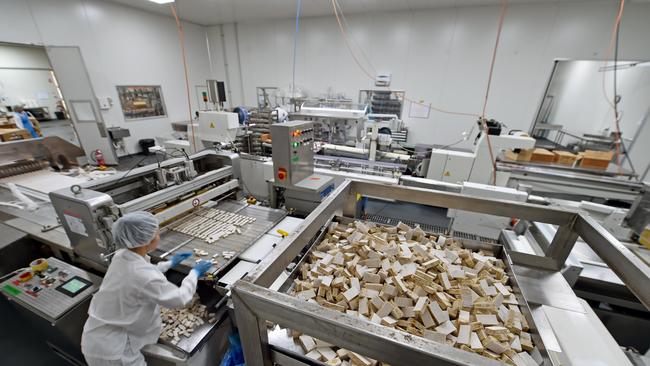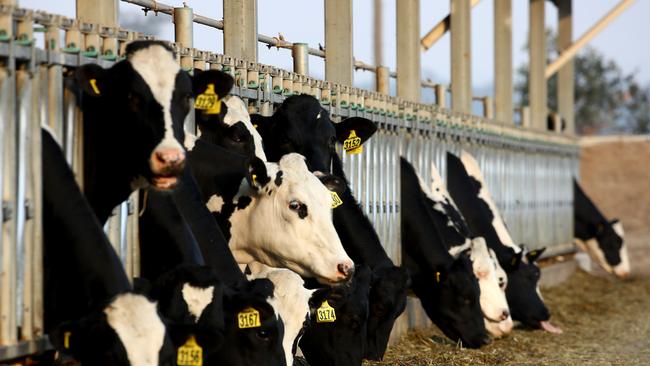Sweet tastes of local success
The rural homes of major food conglomerates are using the pandemic to their advantage; bringing in jobs and awareness to Australian small towns.

At the foot of the Blue Mountains in Lithgow, a factory owned by Italian confectioner Ferrero makes Tic Tacs and Nutella, while on the banks of NSW’s Macleay River in a place called Smithtown, Swiss firm Nestle is manufacturing Milo. There’s a Campbell’s Soup factory operating out of Shepparton in country Victoria, while Mars Wrigley has picked Ballarat to produce Maltesers and M&Ms.
The cities and towns of regional Australia have for decades been home to some of the world’s largest food conglomerates, helping to create a $127bn industry and the largest manufacturing sector in the country.
Recently deemed by the Industry, Science and Technology Minister Karen Andrews as “essential”, the food, beverage and grocery sector has also turned out to be a bit of a lifeline for the economy, too, as it limps through the fallout from COVID-19.
And while Australia’s food manufacturing hubs still favour major cities and urban areas over the regions in a rough 60:40 split, with the right government incentives and private investment, there are many in the country hoping that the viral outbreak will help swing that pendulum towards the regional areas, bringing jobs and people with them.
“The pandemic has provided an opportunity to highlight the advantages of living out of big densely populated ‘COVIDy’ cities,” says Shane Van Styn, mayor of greater Geraldton in Western Australia and chair of Regional Capitals Australia, an alliance of 51 of the country’s smaller cities.
“It has shone the light on fresh produce, the clean green nature of the regions and that romantic notion of paddock to plate,” Van Styn says.
‘Can regional Australia compete with industrial suburbs and cities to attract that investment in the sector? There is no significant reason why they can’t’
He also notes that the regional capital cities, home to more than eight million people including the surrounding areas, have significant and affordable greenfield sites that are often owned by government, which could lure more food manufacturers away from the big cities. That is thanks to the location of the facilities, their close proximity to ports, rail and airports, and to the raw ingredients produced by the farmers nearby.
Turnover for Australia’s food and grocery sector grew 4.6 per cent in the 2018/2019 financial year to $127.1bn, according to the most recent available industry data.
The sector also employed 274,835 people, an increase of 0.7 per cent on the previous 12-month period and accounted for 39.6 per cent of regional employment.
Dr Geoffrey Annison, deputy chief executive of the Australian Food and Grocery Council, says that after the industry’s early successes in the 1990s, when Australia became a net exporter of food with 8 per cent year-on-year growth, food manufacturing during the past decade has plateaued.
The slowdown in growth is in part due to some offshoring by manufacturers to take advantage of lower input costs, layers of regulation at both a state and federal level, long periods of drought, a strong Australian dollar, several years of price deflation and an extreme concentration in the retail sector between two major supermarkets. Namely, Woolworths and Coles.
“If (the supermarkets) are reticent to pass on price increases then it is a bit more difficult for manufacturers to make a dollar and harder to justify reinvestment in the sector,” Annison says. Despite this, “it is a sector that is still making investment and new plants are being built in regional Australia”.
Annison, who has worked in the food industry for his entire career, including at CSIRO, adds that the headwinds that were holding the sector back just six months prior are now starting to reverse thanks to an unlikely source — COVID-19. Not least because the drive by panic-stricken consumers to stockpile groceries boosted demand for non-perishable items. This is also despite the fact that Australia produces enough food to feed the entire population three times over.
“The pandemic has driven greater awareness not only among the community but also among the politicians to the importance of a resilient food and grocery sector,” he says.
“It could also bring industry policy development which might encourage expansion and on-shoring. The focus has been on productivity, jobs, export opportunities and regional Australia.”
That is not to say that the food and grocery sector or the regions have escaped the pandemic unscathed. Food exports have slumped amid weaker demand from China for high-end produce such as lobster and as the cost of airfreight ballooned.
The second wave of the viral outbreak in Victoria hasn’t helped either, with the state’s regional towns taking the biggest hit to employment in the country, analysis from the Grattan Institute has shown.
Annison says that where multinational companies have already chosen to commit more capital, it is often because of the factory’s close proximity to raw-material production, Australia’s educated workforce, a “reasonably reliable” supply of products and low levels of sovereign risk.
In early August, the national COVID-19 Commission chairman Nev Power floated the idea of giving bigger tax concessions and incentives to companies that spend money on local expansion to boost investment, rather than see the money spent overseas. Minister Andrews has said that a reduction in red tape across all levels of governments would also be a boon for manufacturing investment.

Mars Australia, which sells chocolate and chewing gum in more than 180 countries, has six regional manufacturing sites across Victoria, NSW and Queensland.
They have recently committed to spend an extra $37m on their Ballarat chocolate factory, which already churns out 5 billion individual M&Ms a year. From the one site, their products, including Maltesers, Milky Ways and Mars bars, are exported to 17 countries.
“It’s a big investment in the current environment,” says Andrew Leakey, general manager of Mars Wrigley Australia, which is part of Mars Australia that also manufactures and sells speciality pet food. “We’re very committed to Australia across both our markets. We have a big focus on building capabilities, which makes us more efficient and ensures that we can also compete globally.”
The capital injection from the parent company will go towards innovating and upgrading the factory’s infrastructure, retooling existing assets, and investing in equipment and processes to “future proof” the site.
Plans are also in place to see the company’s entire Australian operations rely on renewable energy. By the second half of this year, Mars will source all of its power needs from the Kiamal solar farm in western Victoria.
Other multinationals to commit to the regions include Swiss conglomerate Nestle, which has announced a $90m expansion of their Blayney factory, where Purina pet food is made, and a community grants program at their Milo factory in Smithtown.
In Shepparton, Campbell’s have been investing in sustainable practices to reduce landfill, water and energy usage; while Cadbury’s owner, Mondelez International, has injected more than $100m over the past five years in the company’s chocolate factory at Claremont in Tasmania.
Robert Poole, head of consumer and retail at consultancy firm KPMG, says food manufacturers usually have very pragmatic reasons for choosing a location, based on a number of factors including the type of product being made and the relative cost of processing including transport and logistics.
Fresh milk, for example, is mainly processed in the city while sugar has to be processed rather quickly, so its mills are close to the regions. But if the company has a choice, Poole says it ultimately comes down to a site’s access to utilities, skilled labour, land affordability, infrastructure and transport.
He adds that the big rural cities like Toowoomba in Queensland and Tamworth and Wagga Wagga in NSW with sizeable populations were already competitive with Australia’s major capital cities.
“Can regional Australia compete with industrial suburbs and cities to attract that investment in the sector? There is no significant reason why they can’t,” says Poole. “Generally a government would always love factories to be in the regions, but the incentives are not huge. Most company decisions are made along purely commercial lines.”
He also notes that certain types of food processing, such as the finishing-off of goods for the retail sector, are more suited to the western parts of Sydney or Melbourne, where they have a big population and access to good distribution and warehousing.

Even so, one trend that could accelerate through the pandemic is the relocation of food processing plants on expensive inner-suburban sites to either big industrial estates on the outskirts of the major cities or to the regions, as the assets approach their use-by dates and manufacturers look to innovate.
“Governments want that to happen and industry wants that to happen,” Poole says. “New technology and better practices are always coming available and when the older sites have been fully depreciated on the company’s balance sheet and there is a need to upgrade, the savings and benefits outweigh the cost of moving.”
The National Farmers’ Federation has also called for more public and private investment in the regions, with many manufacturing assets that were commissioned decades earlier in desperate need of innovation and automation.
This includes many regional food factories which it says use out-of-date technology and are labour, water and energy intensive.
“More food manufacturing in the regions will be a catalyst for greater good in regional Australia,” says NFF chief executive Tony Mahar. “It will mean that we will get more investment in infrastructure and jobs, and there will also be a whole range of knock-on benefits that will improve and enhance agriculture as well.”
It could also be a catalyst for energy-efficiency programs which are difficult to get in parts of rural Australia, help install long-reach fibre networks for faster internet and also assist with an upgrade of transport links to major cities and ports.
And with the outbreak of the virus exposing the fragility of the supply chain, Mahar says efficiencies would also be made if manufacturing took place closer to where the food was being produced.
Regional Capitals Australia’s chair Shane Van Styn adds that the general push by consumers towards buying higher quality food, and their greater awareness of nutrition and a product’s carbon footprint, could also play into the hands of the regions and see a move away from big industrial-scale food-manufacturing plants.
“Have we reached the end point of mass-produced plastic food?” he says. “It would certainly be a plus to the regions to see smaller manufacturing and food processing.”
